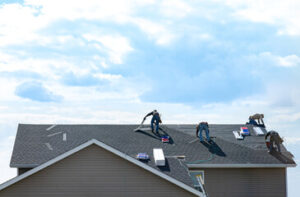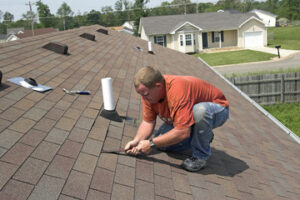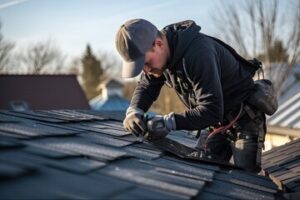A well-maintained roof is your home’s shield against the elements. From whirlwinds and tornadoes to pea-sized hail and raccoons that rip off shingles, a properly functioning roof protects everything inside your home.

When it comes to roof repair, the first thing to do is find the problem. Look for water stains, pooling water, sagging, and dampness. Get professional help from EZ Roofing of Flagler County today.
Flashing is a slender layer of metal that prevents water or moisture from seeping into the spaces between roof structures and other features of your home, such as chimneys, vent pipes, skylights, walls, and dormers. Typically crafted from copper, galvanized steel, or aluminum, flashing creates a watertight seal and redirects rainwater away from vulnerable areas. This ensures that roof components and the interior of your home remain intact and dry, extending the lifespan of your roofing system.
When your roof flashing is damaged, it can cause leaks and other serious problems. Regular roof inspections will help to identify potential issues with your flashing before they become too serious. Look for signs of damage, such as rust or corrosion, or moisture, such as damp stains or peeling paint on the inside of your house. If you find any of these issues, a roof repair contractor can replace or repair your flashing to protect the rest of your home from water intrusion.
Different types of flashing are used for different applications and locations on the roof. Chimney flashing, for example, requires two pieces of flashing in order to ensure that rainwater always meets a waterproof surface and does not seep into the chimney masonry or surrounding shingles. Base flashing, which is installed underneath shingles before chimney work, and counter flashing, which is embedded into the bricks of the chimney, form this two-part flashing system.
Valley flashing, which is used along the ridges of a roof where roof slopes meet, consists of V-shaped or W-shaped pieces that are soldered together to form a watertight seam. Another type of flashing is kickout flashing, which can be installed on the edge of a roof where it meets a vertical wall. This flashing consists of rectangles of sheet metal bent into L-shaped shapes and nailed to the roof deck and then nailed to the vertical part of the dormer or other protrusion.
Regardless of the type of flashing used on your roof, it is important to choose a material that will last as long as possible and resist rust or other forms of deterioration. The most common flashing materials are aluminum and galvanized steel, both of which are highly durable and weather resistant. For an added aesthetic, many homeowners choose to use colored flashing, which can be matched to the color of your roof or trim.
Shingles
Shingles are the most visible element of a roof and provide the first line of defense against moisture and the elements. Through a specific layering pattern, they create a waterproof barrier that keeps rain and other precipitation away from the house’s interior. But, like all materials, shingles do not last forever and will eventually need to be replaced. This damage can be caused by sudden and severe storms, sun exposure, and simply age-related deterioration.
Although a roof replacement is typically more costly than simple repairs, a professional roofer can help determine whether the extent of damage warrants this more drastic option. Minor roof repairs can address specific issues, from sealing cracks to replacing loose shingles. If you find yourself needing to replace shingles, it is important to use a roofing product that matches the color and style of the existing shingle for a seamless look.
If a shingle has curled upward, you can use roofing sealant to glue it back down. Apply a bead of the sealant underneath the curled shingle, press it flat, and weigh it down with a brick for 24 hours. You can also use roof sealant to fill a cracked shingle, but be sure that the crack is not covered by any other shingles; if it is, the repair won’t hold. If possible, collect some shingle granules from your rain gutter and liberally sprinkle them over the wet sealant to camouflage your cracked shingle repair.
You can also repair a shingle that is missing a portion of its edge by inserting a new shingle between the existing upper and lower undamaged shingles. Secure this shingle with roofing sealant and re-nail the overlying shingles wherever you’ve previously removed nails to avoid leaks. Depending on the extent of the damage, it might be more practical to simply remove all of the shingles in the affected area and replace them all at once. This is particularly true if your roof is older and the remaining shingles are showing signs of wear.
Underlayment
The roof underlayment is the first layer that goes on the roof before any other material. It creates a sturdy base for the outer roof covering and protects your home from moisture. It also blocks damaging UV rays, extending the life of your roofing materials.
There are different types of underlayment materials, including felt, rubberized asphalt, and non-bitumen synthetic underlayment. Depending on the roofing material and climate, your contractor may recommend one type over another. Felt underlayment is traditionally made of organic paper that is saturated in asphalt or bitumen. It comes in different weights, known as No. 15 or No. 30 felt, with each option offering varying levels of durability. If you’re going with a traditional felt underlayment, it’s important to keep in mind that it will absorb water and will wrinkle when exposed during the installation process.
Synthetic underlayment is made of a synthetic basemat soaked in asphalt or covered with a layer of fiberglass. Some versions of this underlayment include coarse woven material reinforcement or scrim that adds strength and tear resistance to the underlayment. This type of underlayment is more expensive than felt underlayment, but it offers a number of critical benefits for your roof.
Moisture damage is a major threat to your roof structure and can lead to leaks and other problems. High-quality underlayment prevents water from penetrating the roof deck and protecting the underlying structure from water-related issues like rot.
Waterproof underlayment is also essential for areas of the roof that are prone to leaks, such as valleys, eaves, vents, chimneys, and skylights. Rubberized asphalt underlayment is a common choice because it’s resistant to weather elements and can create a solid waterproof barrier.
Not only does underlayment prevent unwanted water incursion, but it also dampens noise vibrations. This allows you to enjoy your favorite hobbies, focus on work, or get some much-needed rest without worrying about the neighbor’s music or footfalls invading your space. This makes underlayment a valuable investment for your roof’s longevity.
Gutters
Gutters are trough-shaped structures attached to the eave edges of buildings that collect rainwater as it streams down from the roof’s surface. They then dispense the water through downspouts that are routed away from the building’s foundation and into yard drainage systems or into the rainwater collection system, depending on the type of roof. Gutters are essential to the health of a roof, as they prevent water buildup that can lead to structural issues and damage to the roof and walls.
Gutters should be inspected regularly for leaks and other problems. When these are found, they should be repaired as soon as possible to minimize the potential impact on the health of the roof. In addition, the gutters should be cleaned on a regular basis to keep them from becoming clogged.
When a gutter becomes clogged, it can block the flow of water from the roof to the downspout and cause the water to spill over the sides of the gutter. This can damage the fascia boards and the siding of the home. If the gutter is not cleaned on a regular basis, it can become loose and detach from the house, causing further damage to the roof, walls, and foundation.
A poorly functioning gutter system can also encourage the growth of mold and fungus on the roof. This can lead to rot and decay of the roof fascia and trim and the wood siding of the home. Gutters can also promote the growth of moss, which can stain and discolor the siding and paint of the house. Finally, if the gutters are not properly installed and protected, they can attract squirrels, which will chew through them to gain access to the attic. Fortunately, if you have an existing gutter system in place, it’s easy to fix a clogged or damaged one. Just make sure you take the proper safety precautions when working on your roof, such as using a ladder that is secure and using handheld tools with long handles so you can reach all areas of the gutter. Also, be careful not to overstretch when reaching, as this could lead to a fall and serious injuries.

